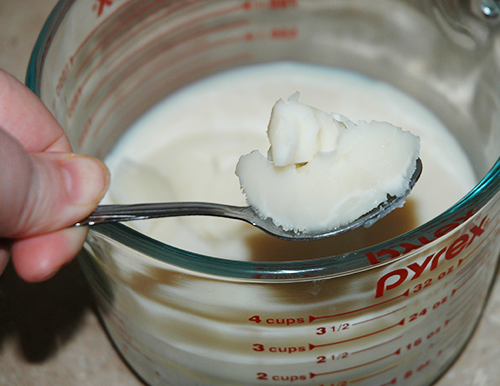 One the the many benefits of making your own meat stocks is all the wonderful fat rendered during the process. A lot of people make the mistake of discarding the fat, thinking that it is unhealthy and that there is no use for it anyway. This is a big mistake. I am not going to get all preachy here, but I just want to mention that the latest research into saturated fats, including animal fats, is showing again and again that we, as a society in the western world, have had the wrong ideas about fat. This, some speculate, may even help explain the growing obesity problems in the world. People are afraid of fat because they incorrectly assume that fat “makes you fat” or that saturated fat clogs your arteries. The truth, it seems, is that saturated fats are not the enemy. In fact eating saturated fats seems to help maintain good cholesterol counts if consumed as a part of a healthy diet, especially if that diet is not high in sugar and other carbohydrates. Okay, I am not going to go into any more detail on that subject right now, because this is a “how to” post, not a diet advice post. I just really wanted to say these things because I think that animal fat is so important not only for health, but in cooking in general. It is the best thing for sauteing anything. If you have enough, you can also use it to deep fry, and you will have the best results you have ever had. Just make some eggs with rendered fat and you will wonder how you ever did without. Also, if you use cast iron skillets, nothing seasons them better. Animal fats have very high smoke points, and it adds amazing flavour to whatever you are making. I used to use olive oil for most of my sauteing. No more. Now it is usually either rendered animal fat, coconut oil, or butter.
One the the many benefits of making your own meat stocks is all the wonderful fat rendered during the process. A lot of people make the mistake of discarding the fat, thinking that it is unhealthy and that there is no use for it anyway. This is a big mistake. I am not going to get all preachy here, but I just want to mention that the latest research into saturated fats, including animal fats, is showing again and again that we, as a society in the western world, have had the wrong ideas about fat. This, some speculate, may even help explain the growing obesity problems in the world. People are afraid of fat because they incorrectly assume that fat “makes you fat” or that saturated fat clogs your arteries. The truth, it seems, is that saturated fats are not the enemy. In fact eating saturated fats seems to help maintain good cholesterol counts if consumed as a part of a healthy diet, especially if that diet is not high in sugar and other carbohydrates. Okay, I am not going to go into any more detail on that subject right now, because this is a “how to” post, not a diet advice post. I just really wanted to say these things because I think that animal fat is so important not only for health, but in cooking in general. It is the best thing for sauteing anything. If you have enough, you can also use it to deep fry, and you will have the best results you have ever had. Just make some eggs with rendered fat and you will wonder how you ever did without. Also, if you use cast iron skillets, nothing seasons them better. Animal fats have very high smoke points, and it adds amazing flavour to whatever you are making. I used to use olive oil for most of my sauteing. No more. Now it is usually either rendered animal fat, coconut oil, or butter.
Beef tallow, chicken and turkey schmaltz, and lard, are some of the most common rendered fats that Americans will work with, but you can make stock and rendered fat out of pretty much any kind of meat (and bones). No matter what you are using, the process is more or less the same. If desired, roast the bones or carcass, or otherwise put the raw bones, carcass, and optional meat into a stock pot, add aromatic vegetables, if desired, simmer for anywhere from 6 to 24 hours, strain the stock, and let it cool. Here you will find all of my stock recipes and you can check those out if you would like more detailed instructions. Once you have completed these steps, you can go onto to the following steps to clean that fat and prepare it for use.
Saturday
Sep 14, 2013
